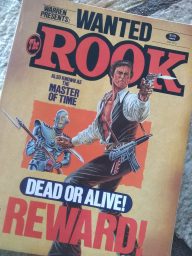 James Warren kicked off the Warren Publishing empire in 1957 with a pair of monster magazines edited by Forrest J. Ackerman, the man widely considered, for better or worse, to have kicked off the culture of sci-fi fandom. Vampirella has proven to be the longest-lasting and perhaps most famous creation of the company, although it did publish a brief run of original adventures of The Spirit, and its anthology titles such as Creepy and Eerie often come up when discussing nostalgia titles. In the late-60s, Warren did an end-run around the Hayes Code by upping the size of his titles to match the magazine on the stands and declaring that, as magazine, the Hayes Code did not apply.
James Warren kicked off the Warren Publishing empire in 1957 with a pair of monster magazines edited by Forrest J. Ackerman, the man widely considered, for better or worse, to have kicked off the culture of sci-fi fandom. Vampirella has proven to be the longest-lasting and perhaps most famous creation of the company, although it did publish a brief run of original adventures of The Spirit, and its anthology titles such as Creepy and Eerie often come up when discussing nostalgia titles. In the late-60s, Warren did an end-run around the Hayes Code by upping the size of his titles to match the magazine on the stands and declaring that, as magazine, the Hayes Code did not apply.
Many of his “magazines and totally not comic books” can still be found in long boxes at most comic book shops with asking prices in the five to ten dollar range. Given the typical 70-80 pages of content packed between covers, that puts the price per page on comparable footing with brand new titles from Marvel or a DC. If you can set aside the sometimes dated fashions and the rounded and somewhat caricature-esque art style of the Spanish studio work, they make for a fine comic fix to feed your addiction between releases of Arkhaven Comic titles.
As one example, take the fix-up first issue of “The Rook”.
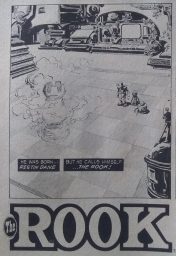 Having seen the cover, you’re probably thinking that this space cowboy is an obvious rip-off of Han Solo. The funny thing is that Restin Dane* first appeared in the March 1977 issue of Eerie – a full two months before Star Wars hit the theaters. It’s possible that early publicity photos of Han Solo inspired creators Bill DuBay and Budd Lewis. Given the long lead time between writing and art production and final publication, it’s a safe bet that what we’re looking at here is more a case of parallel development.
Having seen the cover, you’re probably thinking that this space cowboy is an obvious rip-off of Han Solo. The funny thing is that Restin Dane* first appeared in the March 1977 issue of Eerie – a full two months before Star Wars hit the theaters. It’s possible that early publicity photos of Han Solo inspired creators Bill DuBay and Budd Lewis. Given the long lead time between writing and art production and final publication, it’s a safe bet that what we’re looking at here is more a case of parallel development.
The resemblance of the Time Castle to the Tardis, on the other hand…undeniable. This title is much less of a Han Solo rip-off, and far more of an Americanized Doctor Who complete who trades his sonic screwdriver for a personal side-arm, and who trades an eagerness to run for cover when trouble starts for a pugnacious love of a good fist fight.
If the extensive author notes provided on the inside cover of this issue can be trusted – they serve equal parts design notes and marketing ad copy – the creation of this time-travelling gunslinger came about as a result of several factors. First was Warren’s conviction that a nostalgia fueled kick to the western genre, which had languished for nearly a decade at that point, was in the offing. His belief was likely helped along by the existence of several toy-molds in the cowboy style that could be had for cheap – making production of Rook toys much less of a risk. His rebellious authors felt that a spike in sci-fi interest was around the corner and brought him Restin Dane as a compromise character that could cover both bases.
They were both right, as the Rook became one of the more popular stand-alone characters in the Warren library. Popular enough to justify collecting the serial stories scattered through Eerie into a stand-alone issue that sold well enough to justify a three year run of solo adventures.
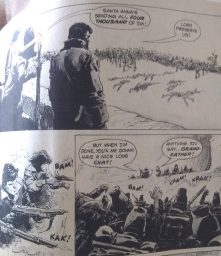 In this first issue, Restin Dane jumps into action having already invented his time-machine, which he has shaped into that of a chess Rook. By recovering ‘time fragments’ to fuel his machine, Rook can travel back in time for durations limited to the needs of the plot. He dubs such travel ‘time castling’ and the writers have enough respect for the intellect of the reader not to spell out exactly why – you don’t often see that level of restraint and trust in the reader on the part of comic publishers these days.
In this first issue, Restin Dane jumps into action having already invented his time-machine, which he has shaped into that of a chess Rook. By recovering ‘time fragments’ to fuel his machine, Rook can travel back in time for durations limited to the needs of the plot. He dubs such travel ‘time castling’ and the writers have enough respect for the intellect of the reader not to spell out exactly why – you don’t often see that level of restraint and trust in the reader on the part of comic publishers these days.
The action kicks off with Rook staggering out of his machine in dire straits. As a red-blooded American proud of his heritage, he sets his first destination as the last days of the Alamo where he tries to save the doomed Texan defenders, and his own great-grandpappy, from “Santa Anna’s all boy marching band”. Even with his advanced 1970’s automatic weapon, the Texans don’t stand a chance. It’s all Rook 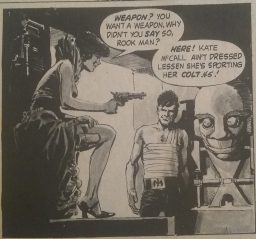 can do to save one young boy and accidentally save one blackhearted scoundrel who inadvertently stows-away on the trip back to the future of 1977. Long story short, that scoundrel decides he wants the machine for himself, and what follows is an old-west adventure complete with old mines, dancing girls, evil deputies, lynch mobs of townies, and robots.
can do to save one young boy and accidentally save one blackhearted scoundrel who inadvertently stows-away on the trip back to the future of 1977. Long story short, that scoundrel decides he wants the machine for himself, and what follows is an old-west adventure complete with old mines, dancing girls, evil deputies, lynch mobs of townies, and robots.
Although courageous and technically proficient, Restin struggles to understand his creation and winds up needing a good rescuing as often as he does the rescuing. He is a high-risk, high-reward kind of guy who takes on some impressive odds, and with the help of a few friends, manages to turn even his defeats into a second chance at victory. Near misses and lucky escapes are the order of the day, as is a constant need to ignore the pain, dig deep, and fight on against all odds. For both Restin and his young gunslinging great-grandfather, who comes along for the adventure more often than not. It’s a wonderful throwback to an era when the pioneer spirit still lived in the American psyche, a healthy romance sub-plot could provided a dash of spice to the narrative, and when a robot could reluctantly sling a gun in defense of a town commandeered by a time-stranded villain.
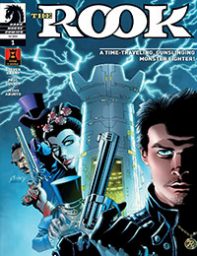 The appeal of such a character has legs long enough to justify an attempted resurrection nearly four decades later. Not having read the Dark Horse version, you’re on your own if you want to take the risk of tracking down their modern version of Restin Dane. If you give the online title in that link a chance, let us know in the comments below.
The appeal of such a character has legs long enough to justify an attempted resurrection nearly four decades later. Not having read the Dark Horse version, you’re on your own if you want to take the risk of tracking down their modern version of Restin Dane. If you give the online title in that link a chance, let us know in the comments below.
Regardless of the quality of the Dark Horse title, the very existence of such a thing proves the appeal of this character. In a more general sense, it proves that those long boxes at your comic shop are full of treasures like these. While you’re waiting for the next AH:Q drop, don’t be afraid to take a chance on them.
*It is not known whether Restin Dane is Roland Dane’s father, but the timing works, and that fact is now part of my own personal head canon for Alt-Hero: Q.
Cool article, Jon! I was a Rook fan back in the day. I started with issue #3. While I didn’t (and don’t) think the series ever quite reached its full potential–which is understandable, since the concept had MASSIVE potential for coolness–it’s still worth checking out. The covers are some of the most “pulp” post-pulp covers ever seen on an American newsstand.
“This title is much less of a Han Solo rip-off, and far more of an Americanized Doctor Who who trades his sonic screwdriver for a personal side-arm, and who trades an eagerness to run for cover when trouble starts for a pugnacious love of a good fist fight.”
This never occurred to me at the time, since I barely even knew about Dr. Who, but I can definitely see the parallels now that you point them out.
The resemblance of the Time Castle to the Tardis, on the other hand…undeniable.
Well…probably. But its worth making the point that there was a very popular UK comic strip called Robot Archie which ran in the Lion comic weekly between the early 50s and the mid 70s. In 1968 he took to time travelling in a machine called The Castle and shaped like…(drum roll please)…a giant chess piece.